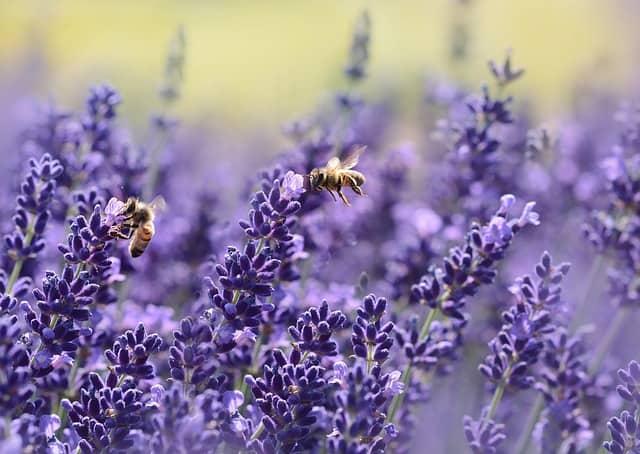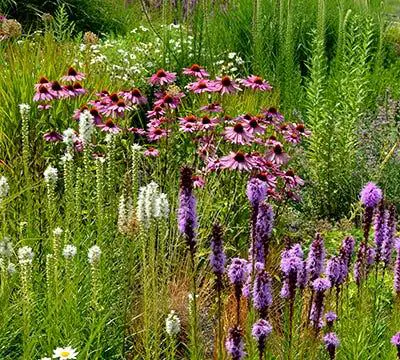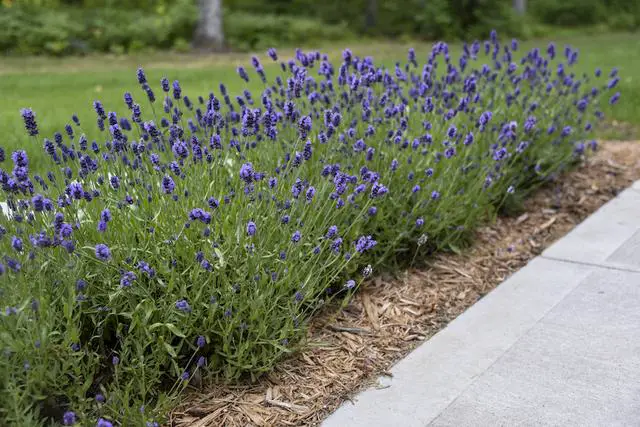Curious about the peculiar dining habits of deer? Discover the intriguing reasons behind their appetite for lavender in this captivating exploration.
1. Understanding the Attraction: Why Do Deer Eat Lavender Plants?

Deer are known to be herbivores, feeding on a variety of plants and vegetation. However, they tend to avoid lavender plants due to their strong fragrance and taste. The powerful scent of lavender acts as a natural deterrent for deer, making them less likely to graze on these plants.
According to Rutgers University’s rating scale for deer damage, lavender is classified as “Rarely Damaged.” This means that deer typically steer clear of lavender unless they are extremely hungry or food is scarce. In such cases, they may be less selective and may nibble on lavender along with other plants.
Why Lavender Repels Deer:
– Strong Fragrance: The intense aroma of lavender is overwhelming for deer and can mask the scents of other more palatable plants.
– Sharp Taste: Lavender leaves have a slightly bitter taste that deer find unappealing.
To further discourage deer from approaching lavender plants, it is recommended to plant them alongside other highly fragrant and sharp-tasting herbs like Russian sage and rosemary. These companion plants create a sensory barrier that deters deer from entering the area.
Methods to Keep Deer Away From Lavender:
– Deer Repellent Products: There are various commercially available deer repellent products that can be sprayed onto the foliage of lavender plants. These repellents emit odors that are unpleasant to deer but not noticeable to humans once dried.
– Homemade Recipes: Many homemade recipes using ingredients like garlic, hot peppers, or soap can also be effective in deterring deer. These recipes can be found online and offer an affordable alternative to store-bought repellents.
– Rotation of Repellents: It is advisable to rotate between different types of repellents periodically. This prevents deer from becoming accustomed to a particular taste or scent, ensuring their effectiveness over time.
Recovering Lavender Plants After Deer Damage:
If deer have nibbled on your lavender plants and left them looking tattered, it is important to take appropriate steps for their recovery. After the blooming season, trim back the foliage by about one-third of the plant’s overall size. This not only improves the plant’s appearance but also promotes better branching and growth for the following spring.
In conclusion, while deer may occasionally nibble on lavender plants when desperate for food, they generally find them unpalatable due to their strong fragrance and taste. By using companion planting techniques and employing repellents, gardeners can successfully protect their lavender plants from deer damage.
2. Unraveling the Mystery: The Reasons Behind Deer’s Appetite for Lavender
Deer are known for their selective feeding habits, and it is often a mystery why they choose certain plants over others. However, when it comes to lavender, deer seem to have a particular appetite.
One possible reason for this is the high sugar content in lavender plants. Deer have a sweet tooth and are attracted to plants that offer a high sugar reward. Lavender flowers produce nectar, which is rich in sugars, making them an appealing treat for deer.
Additionally, deer may be drawn to the tender new growth of lavender plants. These young shoots are more succulent and nutritious compared to older foliage, making them a preferred choice for hungry deer.
Another factor that might contribute to deer’s appetite for lavender is its texture. Lavender leaves are soft and pliable, which makes them easy for deer to chew and digest. This makes lavender an attractive option for grazing.
Despite these reasons, it is important to note that deer generally find lavender unpalatable due to its strong fragrance and taste. While they may occasionally nibble on it when food is scarce, they typically avoid it as much as possible.
To deter deer from eating your lavender plants, planting them alongside other highly fragrant and sharp-tasting herbs can be effective. The strong scents of herbs like Russian sage and rosemary can help repel wandering deer.
There are also various commercial repellent products available that can be applied to the plants to deter deer from nibbling on them. These products work by emitting odors that are unpleasant to deer but not noticeable to humans once dried.
It is recommended to rotate between different types of repellents periodically so that deer do not become accustomed to a particular taste or scent.
In case your lavender plant does get damaged by deer, trimming back the foliage after blooming can help promote better growth for the following season. This will also give the plant a neater appearance.
Overall, while deer may occasionally find lavender plants appetizing, their strong fragrance and taste usually make them less appealing. By taking preventive measures and using repellents, you can help ensure that your lavender plants remain unharmed and thriving.
3. Exploring the Palatability of Lavender to Deer: A Closer Look at Their Feeding Habits

Deer populations generally find lavender plants unpalatable due to their strong fragrance and taste. According to Rutgers University’s rating scale, lavender is classified as “Rarely Damaged” by deer. This means that deer tend to steer clear of lavender plants and do not cause significant damage to them.
However, it is important to note that if deer are extremely hungry or food is scarce, they may be less selective in their feeding habits. In such cases, they may still nibble on lavender plants along with other vegetation.
To deter deer from eating lavender, planting it alongside other highly fragrant and sharp-tasting herbs like Russian sage and rosemary can be effective. These strong scents and tastes make the area less appealing for deer, reducing the chances of them approaching the plants.
There are also various store-bought deer repellent products available in the market, as well as homemade recipes that can be found online. These repellents can help keep deer away from lavender by emitting odors that are unpleasant for them. It is recommended to rotate between different repellents so that deer do not become accustomed to a particular taste or scent.
In case deer do nibble on lavender plants and cause damage, it is advisable to trim back the foliage by about 1/3 of the plant’s overall size after blooming. This will not only neaten the appearance of the plant but also promote better branching and growth for the following spring season.
Overall, while lavender is generally unappealing to deer due to its strong fragrance and taste, it is essential to take preventive measures like planting companion herbs and using repellents to ensure their protection against potential feeding habits of hungry or less selective deer.
Sources:
– Rutgers New Jersey Agricultural Experiment Station ‘Landscape Plants Rated by Deer Resistance’ 2018
4. The Scent that Deters: How Lavender’s Fragrance Keeps Deer Away (Most of the Time)
Lavender plants have a strong fragrance that is highly unappealing to deer. This scent acts as a natural deterrent, keeping deer away from the plants. The powerful aroma of lavender is not only unpleasant to deer, but it also masks the scents of other plants that may be more enticing to them.
When deer come across lavender, they are immediately repelled by its strong fragrance and taste. This makes them less likely to graze on the plant and more likely to move on to find other food sources.
In addition to its fragrance, lavender can also be planted alongside other highly fragrant and sharp-tasting herbs like Russian sage and rosemary. These plants work together to create a barrier of scents that deer find unappealing. By planting these herbs together, gardeners can further deter deer from entering their gardens.
While lavender’s scent is effective at keeping most deer away, it’s important to note that hungry deer may still nibble on the plants if food is scarce. In such cases, additional measures may need to be taken to protect the lavender from being damaged.
There are various store-bought deer repellent products available in the market that can effectively deter deer from nibbling on lavender plants. Additionally, homemade recipes for deer repellents can be found online and are often just as effective.
It’s recommended to rotate between different types of repellents so that deer do not become accustomed to a particular taste or scent. By doing so, gardeners can ensure that their lavender plants remain protected throughout the year.
If a lavender plant does get damaged by deer, it is possible for it to recover. After blooming season, trim back the foliage by about one-third of the plant’s overall size. This will help tidy up the appearance of the plant and promote better branching and growth for the following spring.
Overall, the strong fragrance of lavender makes it an excellent choice for gardeners looking to deter deer from their gardens. By combining lavender with other fragrant herbs and using repellents when necessary, gardeners can enjoy the beauty and fragrance of lavender without worrying about deer damage.
5. Strategies to Protect Your Lavender from Hungry Deer: Tips and Tricks for Gardeners

1. Planting Companion Herbs
One effective strategy to keep deer away from your lavender plants is to plant companion herbs that have strong fragrances and sharp tastes. Lavender can be planted alongside herbs like Russian sage and rosemary, which also repel deer due to their strong scents. By creating a barrier of these highly aromatic plants, you can deter deer from approaching your lavender.
2. Using Deer Repellent Products
There are various store-bought deer repellent products available in the market that can be applied to your lavender plants. These repellents are designed to emit odors that are unpleasant for deer, effectively keeping them at bay. Additionally, there are homemade recipes for deer repellents that you can find online and make yourself. It is recommended to rotate between different repellents so that deer do not become accustomed to a particular scent or taste.
3. Trimming and Pruning After Deer Damage
If your lavender plants have been nibbled on by deer and appear tattered, it is advisable to trim back the foliage by about one-third of the plant’s overall size after blooming. This will help neaten the appearance of the plant and promote better branching and growth for the following spring season.
4. Understanding Deer Behavior
It is essential for gardeners to understand deer behavior when trying to protect their lavender plants. While lavender is generally unpalatable to deer due to its strong fragrance, hungry deer may still feed on it when food sources are scarce. Therefore, it is important to consider other factors like seasonal availability of food when implementing protective strategies.
5. Creating Physical Barriers
Another option for protecting your lavender plants from deer is to create physical barriers. This can be done by installing fences or netting around your garden area. Make sure the barriers are tall enough and properly secured to prevent deer from jumping over or pushing through them.
By implementing these strategies, you can increase the chances of keeping deer away from your lavender plants and enjoy their beauty and fragrance in your garden.
6. Restoring Your Ravaged Lavender: Steps to Revive Plants After a Deer Feast

After a deer feast on your lavender plants, it is important to take steps to restore them and promote their recovery. Here are some tips to revive your ravaged lavender:
1. Trim the foliage
If the deer have left your lavender plant looking tattered and damaged, it is advisable to trim back the foliage by about one-third of the plant’s overall size. This will not only neaten the appearance of the plant but also encourage better branching and growth for the following spring season.
2. Provide proper care
To aid in the recovery process, make sure you provide your lavender plants with proper care. This includes watering them regularly, especially during dry periods, and ensuring they receive adequate sunlight. Lavender thrives in well-draining soil, so make sure to avoid overwatering which can lead to root rot.
3. Fertilize appropriately
To help your ravaged lavender plants regain their strength, consider fertilizing them with a balanced organic fertilizer. This will provide essential nutrients that will support their growth and recovery.
4. Protect from future deer damage
In order to prevent further damage from deer, it is important to take measures to protect your lavender plants. Along with planting other highly fragrant and sharp-tasting herbs like Russian sage and rosemary, you can also use store-bought deer repellents or homemade recipes found online that effectively deter deer from nibbling on your plants.
Remember that deer have a highly developed sense of smell, so rotating different repellents will prevent them from becoming accustomed to a particular taste or scent.
By following these steps and providing proper care and protection, you can revive your ravaged lavender plants after a deer feast and ensure their healthy growth in the future.
In conclusion, deer are attracted to lavender due to its strong scent and taste, which they find appealing. While lavender is not a preferred food source for deer, it may be consumed when other resources are scarce or as a result of curiosity. Understanding the factors that drive deer to eat lavender can help gardeners and farmers implement effective strategies to deter them from damaging these plants.











































